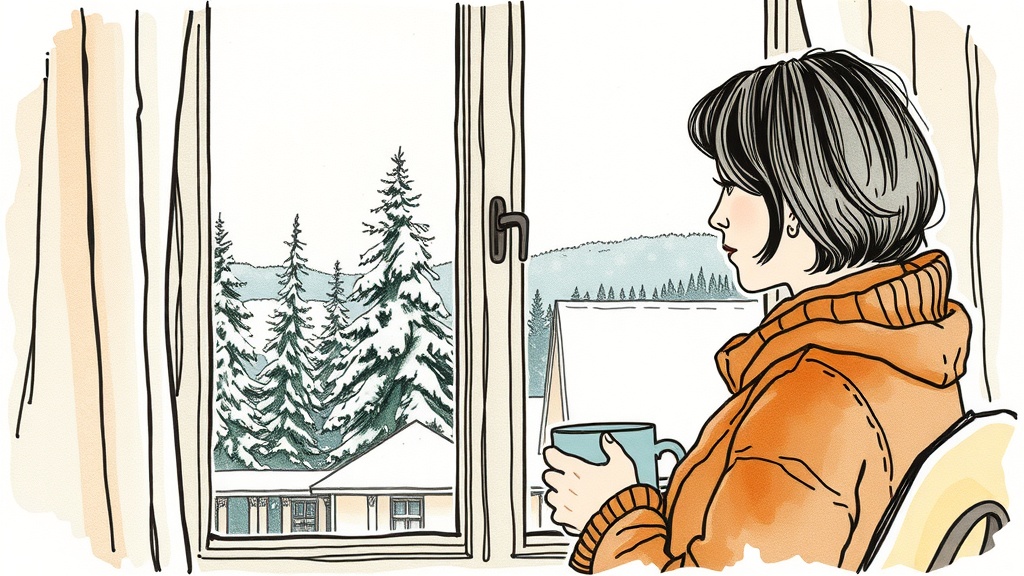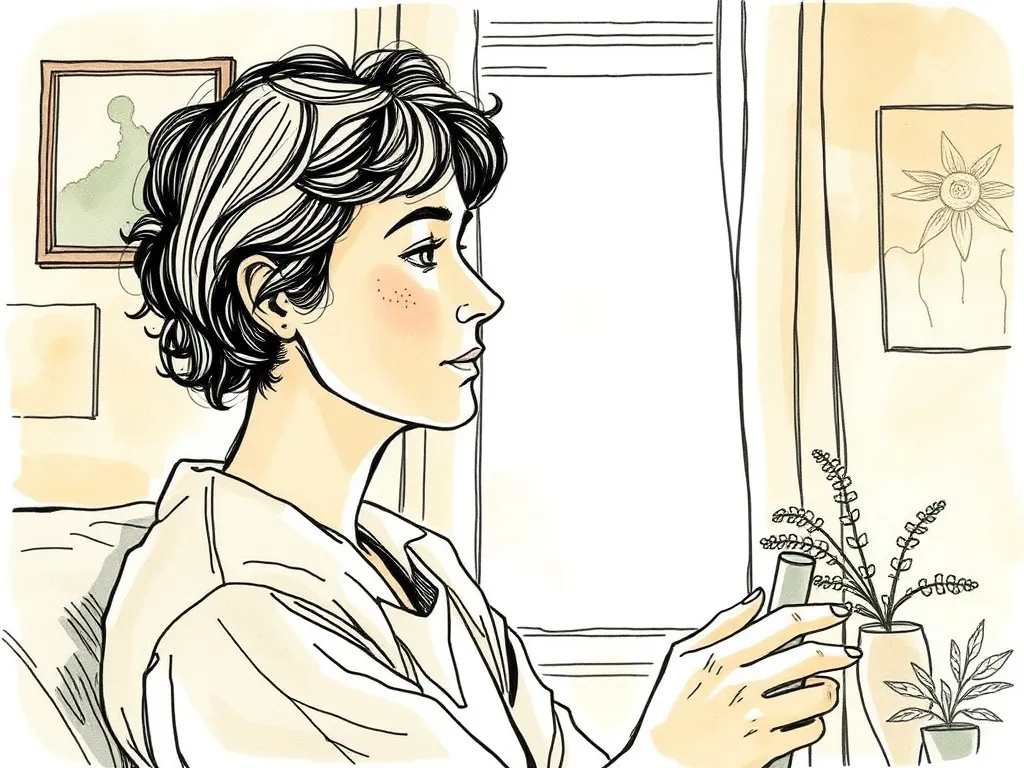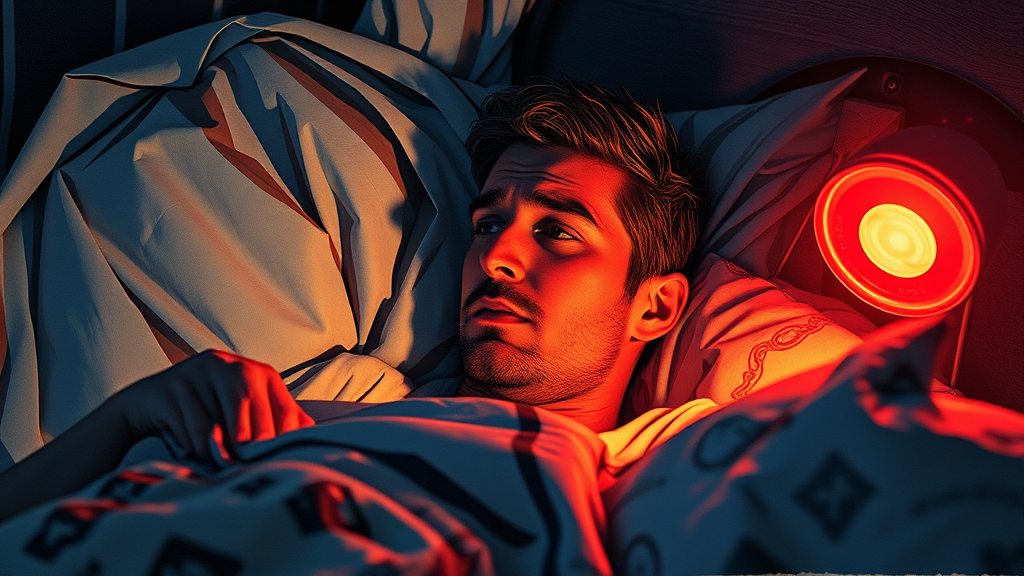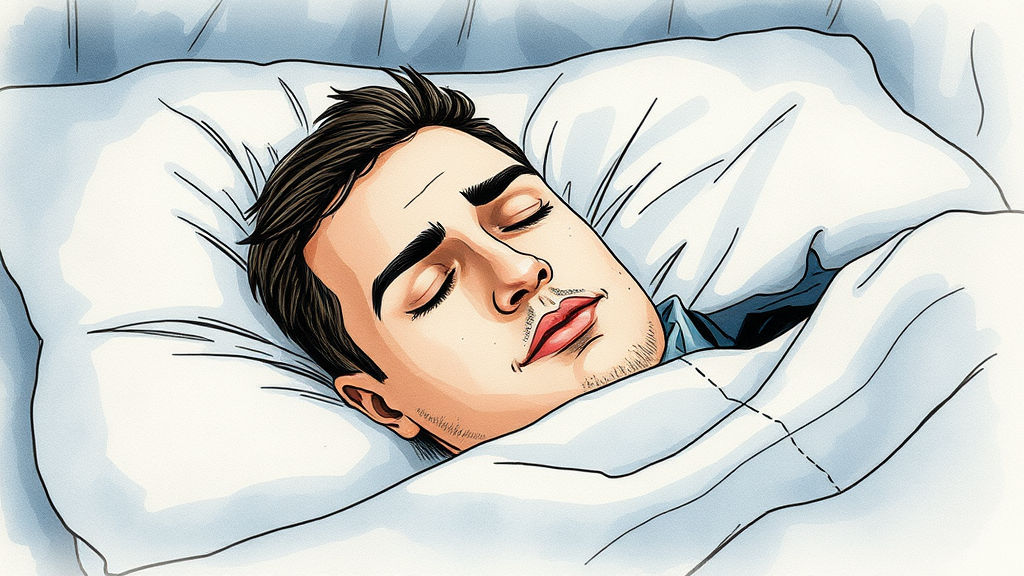· Don Schmidt · Guides · 11 min read
The Winter Blues and Your Sleep: Managing Seasonal Affective Disorder (SAD) and Insomnia in Alberta
Manage winter blues and insomnia in Alberta. Discover strategies for Seasonal Affective Disorder (SAD), including light therapy, CBT-I, and lifestyle tips.

Introduction: Embracing the Winter in Alberta
Winter in Alberta is undeniably beautiful, with its crisp air, sparkling snow, and dramatic skies. However, for many, the beauty of the season comes with a significant challenge: the drastic reduction in daylight hours. The short, dark days, especially from late fall through early spring, can profoundly impact our mood, energy levels, and, crucially, our sleep patterns. This phenomenon, often referred to as the “winter blues,” can escalate into a more severe condition known as Seasonal Affective Disorder (SAD), frequently intertwined with sleep disturbances like insomnia.
In this comprehensive guide, we’ll delve into the intricate relationship between the winter blues, SAD, and insomnia, with a specific focus on the unique challenges faced by Albertans. We’ll explore the science behind these conditions, discuss effective strategies for management—from light therapy to Cognitive Behavioral Therapy for Insomnia (CBT-I)—and provide practical tips to help you navigate the colder, darker months with better sleep and improved mental well-being. Our goal is to empower you with the knowledge and tools to not just survive, but thrive, through Alberta’s long winter.
Understanding the Winter Blues and Seasonal Affective Disorder (SAD)
Before we can effectively manage the impact of winter on our sleep, it’s important to understand the conditions themselves. The “winter blues” is a common, milder form of seasonal mood change, characterized by feelings of sadness, lethargy, and a general lack of motivation as the days grow shorter. While uncomfortable, these symptoms typically don’t severely impair daily functioning.
What is Seasonal Affective Disorder (SAD)?
Seasonal Affective Disorder (SAD) is a type of depression that recurs with a seasonal pattern, most commonly starting in the fall and continuing into the winter months. Unlike the milder winter blues, SAD symptoms are more severe and can significantly impact a person’s quality of life. Common symptoms of winter-pattern SAD include:
- Persistent low mood: Feeling sad, irritable, or “down” for most of the day, nearly every day.
- Loss of interest: No longer enjoying activities you once did.
- Low energy (lethargy): Feeling sluggish, heavy, or drained.
- Increased need for sleep (hypersomnia): Sleeping more than usual, but still feeling tired.
- Carbohydrate cravings: Leading to weight gain.
- Difficulty concentrating: Problems focusing on tasks.
- Social withdrawal: A tendency to avoid social activities.
While the exact cause of SAD isn’t fully understood, it’s strongly linked to the reduction in sunlight exposure during winter. This lack of light can disrupt your internal body clock (circadian rhythm), leading to a drop in serotonin levels (a brain chemical that affects mood) and an overproduction of melatonin (a hormone that regulates sleep).
Why Alberta? The Unique Challenges for Albertans
Alberta, being located at a relatively high latitude, experiences particularly short daylight hours during winter. Cities like Edmonton and Calgary see significantly reduced sunlight compared to more southerly regions. For instance, in December, Edmonton experiences less than 8 hours of daylight, compared to over 9 hours in Toronto and over 10 hours in Vancouver. This prolonged period of diminished light can exacerbate the symptoms of SAD for many residents.
The often extreme cold also limits opportunities for outdoor activity, which is crucial for natural light exposure and mood regulation. Furthermore, unique weather phenomena, like the warm Chinook winds in Southern Alberta, can also disrupt sleep for some, adding another layer of complexity to sleep management. You can learn more about how unique Alberta weather phenomena like Chinooks can impact sleep in our article on coping with weather-related insomnia, such as that caused by Chinook winds in Southern Alberta.
The Link Between SAD and Insomnia
While SAD is often associated with hypersomnia (sleeping too much), it can also paradoxically lead to insomnia for some individuals. The core issue lies in the disruption of the body’s natural sleep-wake cycle.
Circadian Rhythm Disruption
Your circadian rhythm, or internal body clock, is primarily regulated by light and darkness. When daylight hours decrease, this rhythm can become desynchronized. Your body might not receive the clear signals it needs to know when to be awake and when to be asleep. This desynchronization can manifest as:
- Difficulty falling asleep: Despite feeling tired, your body isn’t ready for sleep at the usual time.
- Frequent night waking: Your sleep architecture might be fragmented.
- Early morning waking: Waking up too early and being unable to fall back asleep.
Melatonin Imbalance
Melatonin is a hormone produced by the pineal gland in response to darkness, signaling to your body that it’s time to sleep. In SAD, the prolonged darkness can lead to an overproduction of melatonin, which can make you feel excessively sleepy during the day. However, an irregular light-dark cycle can also confuse the melatonin production, leading to melatonin being released at inappropriate times, thereby contributing to nighttime wakefulness and overall poor sleep quality, despite the increased desire to sleep.
Strategies for Managing SAD and Insomnia
Effectively managing SAD and its associated insomnia requires a multi-pronged approach that addresses both the underlying mood disorder and the sleep disturbances.
Light Therapy (Phototherapy)
Light therapy is a frontline treatment for SAD. It involves daily exposure to a special light box that emits a very bright light (typically 10,000 lux) that mimics natural outdoor light, but without harmful UV rays. The goal is to compensate for the lack of natural sunlight in winter.
- How to use: Typically used for 20-60 minutes each morning, shortly after waking. The light should be positioned to shine indirectly into your eyes.
- Benefits: Can help reset your circadian rhythm, suppress melatonin production during the day, and boost serotonin levels, leading to improved mood and energy, and better sleep quality at night.
Lifestyle Adjustments
Small changes to your daily routine can make a big difference in managing both SAD and insomnia:
- Maximize natural light exposure: Try to get outdoors, even for short periods, during daylight hours, especially in the morning. Open blinds and curtains at home and work.
- Regular exercise: Physical activity can boost mood and improve sleep quality. Aim for at least 30 minutes of moderate exercise most days of the week, ideally earlier in the day.
- Balanced diet: Focus on whole foods, lean proteins, and complex carbohydrates. Limit sugar and processed foods, which can cause energy crashes and disrupt sleep.
- Maintain a consistent sleep schedule: Go to bed and wake up at the same time every day, even on weekends. This reinforces your circadian rhythm.
- Create a relaxing bedtime routine: Wind down with activities like reading, a warm bath, or gentle stretching. Avoid screens before bed.
- Stay connected: Social isolation can worsen SAD. Make an effort to connect with friends and family, even if it’s virtually.
Cognitive Behavioral Therapy for Insomnia (CBT-I)

CBT-I is a highly effective, evidence-based treatment for chronic insomnia, and it’s particularly beneficial when insomnia is linked to mood disorders like SAD. Unlike sleeping pills, CBT-I addresses the underlying thoughts and behaviors that contribute to sleep problems. It involves several components:
- Sleep Restriction: Temporarily reducing time in bed to increase sleep drive and consolidate sleep.
- Stimulus Control: Re-associating your bed and bedroom with sleep and only sleep.
- Cognitive Restructuring: Challenging and changing unhelpful thoughts about sleep.
- Sleep Hygiene Education: Practical tips for a sleep-conducive environment and habits.
For many, CBT-I offers a safe and lasting solution to sleep difficulties. It’s often recommended as a first-line treatment, even being recognized as a safe and effective alternative to traditional sleeping pills, especially for older adults in Alberta seeking better sleep strategies. You can also dive deeper into specific CBT-I techniques like sleep restriction therapy for more detailed guidance.
Medication and Professional Support
If lifestyle changes and light therapy aren’t sufficient, your doctor may suggest medication. Antidepressants, particularly selective serotonin reuptake inhibitors (SSRIs), can be effective for SAD. Always discuss the risks and benefits with a healthcare professional.
Psychotherapy, such as traditional cognitive behavioral therapy (CBT), can also be very helpful for managing SAD symptoms, addressing negative thought patterns, and developing coping mechanisms.
Navigating the Alberta Health System for Support
Accessing mental health and sleep support in Alberta is possible through various avenues. Your first step should typically be your family physician, who can provide initial assessment, offer basic advice, and make referrals to specialists if needed.
- Public Health Services: Alberta Health Services (AHS) offers mental health services, including some programs for depression and sleep disorders. Wait times can vary.
- Private Practitioners: Many psychologists, psychiatrists, and therapists in Alberta offer services privately. While this usually involves a fee, it can offer quicker access to specialized care, including CBT-I.
Understanding how to navigate the Alberta health system for public and private CBT-I options is crucial for finding the right support for your needs. Exploring these pathways can significantly improve your chances of effective treatment.
Practical Tips for Albertans to Beat the Winter Blues and Improve Sleep
Beyond general strategies, here are some specific tips for those living in Alberta:
- Embrace the daylight, even if it’s cold: Bundle up and take advantage of every sliver of sunlight. A brisk walk during your lunch break, or even just sitting by a window, can make a difference.
- Invest in Vitamin D: Given the limited sunlight, many Albertans are deficient in Vitamin D, which plays a role in mood and bone health. Talk to your doctor about appropriate supplementation.
- Consider a Winter Holiday: If feasible, a short trip to a sunnier destination in the darkest months can provide a much-needed boost and help reset your internal clock.
- Plan indoor activities: Combat social withdrawal by proactively planning indoor social gatherings, joining a class, or pursuing hobbies that keep your mind engaged.
- Prepare your home for winter: Optimize your living space for light and comfort. Use warm lighting, consider smart bulbs that mimic sunrise, and keep your home cozy.
- Be aware of seasonal sleep shifts: Recognize that your body might naturally want to sleep more in winter. While SAD can lead to hypersomnia, it’s also important to differentiate between a healthy adjustment and a depressive symptom. Balancing your sleep needs and avoiding oversleeping that leads to daytime lethargy is key.
It’s also worth considering how Albertans effectively manage sleep through drastic seasonal light changes not just in winter, but during the extended daylight hours of summer as well, as the principles of circadian rhythm management remain relevant.

When to Seek Professional Help
While this article provides many strategies, it’s crucial to know when to seek professional help. If your symptoms of SAD or insomnia are severe, persistent, interfere with your daily life, or if you experience thoughts of self-harm, please reach out immediately. A healthcare professional can provide an accurate diagnosis and tailor a treatment plan for your specific needs.
Conclusion: Finding Light in Alberta’s Winter
The winter blues and Seasonal Affective Disorder, often accompanied by insomnia, are real challenges for many Albertans. However, with a combination of informed strategies—including light therapy, targeted lifestyle adjustments, and evidence-based therapies like CBT-I—it is absolutely possible to mitigate their impact. By proactively addressing your mood and sleep, you can embrace the unique beauty of an Alberta winter without sacrificing your well-being. Remember, help is available, and taking the first step towards better sleep and mental health is a journey worth pursuing.
Frequently Asked Questions (FAQ)
Q1: Is SAD only related to light, or are other factors involved?
While lack of natural light is the primary trigger for SAD, other factors can play a role, including genetics, existing mental health conditions, and individual differences in brain chemistry (like serotonin and melatonin regulation). Lifestyle factors such as diet, exercise, and social interaction also influence its severity.
Q2: Can natural sunlight provide enough light therapy for SAD?
While getting outdoors during daylight hours is highly beneficial and recommended, natural sunlight alone often isn’t enough to treat moderate to severe SAD, especially during Alberta winters when the sun’s intensity is low and hours are short. Light therapy lamps are specifically designed to deliver a much higher intensity of light (typically 10,000 lux) that effectively mimics summer sunlight and can produce the necessary therapeutic effect.
Q3: How quickly can I expect to see results from light therapy?
Many people notice an improvement in their energy levels and mood within a few days to two weeks of consistent, proper use of a light therapy lamp. Sleep patterns may take a bit longer to regulate. It’s important to use the light therapy device daily and at the recommended time for optimal results.
Q4: Is CBT-I effective for insomnia linked to SAD, even if I feel depressed?
Yes, CBT-I is highly effective for insomnia, even when it’s co-occurring with depression or SAD. By addressing the cognitive and behavioral factors that perpetuate insomnia, CBT-I can improve sleep quality, which in turn can positively impact mood. For individuals with SAD, combining CBT-I with light therapy and other SAD treatments often yields the best results.
Q5: What’s the main difference between the “winter blues” and SAD?
The main difference lies in severity and impact on daily life. The “winter blues” refers to a milder dip in mood and energy during winter months, which typically doesn’t significantly impair functioning. Seasonal Affective Disorder (SAD), however, is a clinical diagnosis of recurrent depression with a seasonal pattern, where symptoms are more severe, persistent, and cause significant distress or functional impairment, similar to major depression.
Assess Your Sleep Quality Today
Take our My Sleep Health Score assessment to get personalized insights about your sleep patterns and discover how CBT-I can help you achieve better sleep.

Don Schmidt
15+ years of experience in sleep therapy and Cognitive Behavioral Therapy for Insomnia (CBT-I). Passionate about connecting individuals struggling with sleep disorders to evidence-based, non-medical treatment solutions. Author of hundreds of articles and comprehensive guides on sleep health, CBT-I techniques, and overcoming insomnia. When not helping clients achieve better sleep, you can find me hiking with my family and dogs or enjoying a good book.
Ready to connect with a provider?
Allow us to connect you with a provider who can help.



